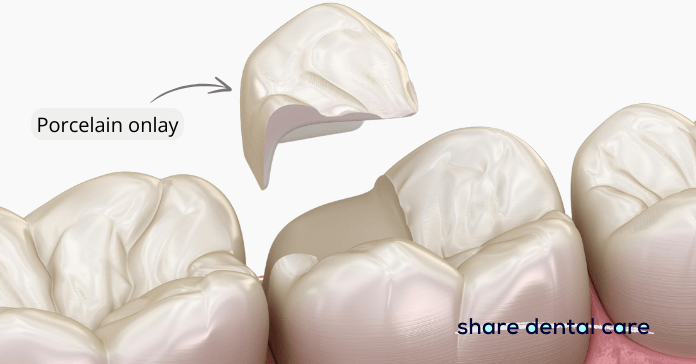Porcelain Onlay is a dental restoration that restores the aesthetics and function of damaged or decayed teeth. It is a more conservative alternative to crowns as it requires less removal of the tooth structure. Porcelain onlays blend seamlessly with the natural tooth color, making them virtually undetectable. In this blog post, we will discuss the porcelain onlay, its benefits, and the process of getting one.
What is a Porcelain Onlay?
Dental onlays, also known as partial crowns, are restorations that cover one or more cusps (projections) of a tooth. They partially cover the tooth, unlike dental crowns that cover the entire tooth. Dental onlay can be made of:
- Composite resin
- Porcelain
- Gold
Porcelain onlays are custom-made in dental laboratories based on an impression of the patient’s tooth. They are designed to fit perfectly on the damaged or decayed tooth, restoring its shape and function. Porcelain is chosen as it closely resembles natural teeth in color and translucency, making it the ideal material for onlays that blend with existing teeth seamlessly.

What is The Difference Between Porcelain Inlay and Onlay?
Porcelain onlay and inlay are similar dental restorations that have slight differences. Inlays are limited to the area between the cusps of a tooth, while onlays extend over one or more cusps.
Inlays are used when there is minimal damage to the tooth structure, while onlays are used when there is extensive damage or decay. Both inlays and onlays are made of the same materials and require a similar procedure for placement.
What are The Benefits of Porcelain Onlay?
- Aesthetic Appeal: As mentioned earlier, porcelain onlay is designed to match the color of natural teeth, making them virtually undetectable. This makes them an ideal choice for visible teeth.
- Preservation of Tooth Structure: Unlike dental crowns that require significant removal of tooth structure, porcelain onlays preserve more of the natural tooth. This is because they only cover the damaged or decayed parts, leaving the healthy parts intact.
- Durability: Porcelain onlays are known for their strength and durability. With proper care, they can last for many years without needing replacement.
- Easy Maintenance: Porcelain onlays are resistant to staining and can be easily maintained with regular brushing, flossing, and dental check-ups.
Composite vs. Porcelain Onlay: Which is Better?
Composite resin onlays are a popular choice for their aesthetics and affordability. However, porcelain onlays offer several advantages over composite resin, including:
- Superior strength and durability
- Resistance to staining and discoloration
- More natural appearance
- Better longevity
While composite resin onlays can last 5-7 years, porcelain onlays can last up to 15 years with proper care. They are also less likely to cause gum irritation and can be polished for a smoother finish.
How is The Procedure Performed?
The procedure for getting a porcelain onlay is similar to a dental crown. It usually requires two visits to the dentist. In the first visit, the dentist will prepare the tooth by removing any decayed or damaged parts and taking impressions of the tooth to create a custom, porcelain onlay. A temporary onlay is placed while the permanent one is being made in a dental laboratory.
In the second visit, the temporary onlay is removed, and the permanent one is placed and bonded onto the tooth using a special adhesive. The dentist will ensure that the fit and appearance of the onlay are perfect before cementing it permanently in place.
Porcelain Onlay vs. Crown
Both porcelain onlays and crowns serve the same purpose of restoring damaged teeth. Also, both require multiple dental visits for the procedure to be completed. However, there are some key differences between porcelain onlays and crowns, such as:
- Coverage: As mentioned earlier, an onlay covers only a portion of the tooth, while a crown covers the entire tooth.
- Tooth preparation: Onlays require less removal of tooth structure compared to crowns. They are bonded to the tooth, unlike crowns that require the tooth to be shaped and reduced significantly. This makes porcelain onlay a more conservative option as it preserves more of the natural tooth structure.
- Protection: As onlays cover only a portion of the tooth, they are not as protective as crowns. Crowns provide complete coverage and protection to damaged teeth.
Consult your dentist to determine which option is best for your specific dental needs.
Caring for Your Porcelain Onlay
Proper care and maintenance are essential to ensure the longevity of your porcelain onlay. Here are some tips to help you take care of your new restoration:
- Brush your teeth twice a day with a soft-bristled toothbrush and fluoride toothpaste.
- Floss daily to remove plaque from between your teeth.
- Avoid using your teeth to open packages or bite on hard objects, such as ice or pens.
- Visit your dentist regularly for check-ups and professional cleanings. They can detect any issues with your onlay early on and provide necessary treatment to prevent further damage.
Conclusion
Porcelain onlays are a popular and effective option for restoring damaged teeth. They offer many benefits, such as aesthetic appeal, durability, and conservation of natural tooth structure. With proper care and maintenance, your porcelain onlay can last many years, providing you with a beautiful and healthy smile.
If you have any questions or concerns about porcelain onlays or other dental restorations, don’t hesitate to consult with your dentist. They can provide you with personalized recommendations based on your specific dental needs.
Remember, a healthy and beautiful smile starts with good oral hygiene practices and regular visits to the dentist.